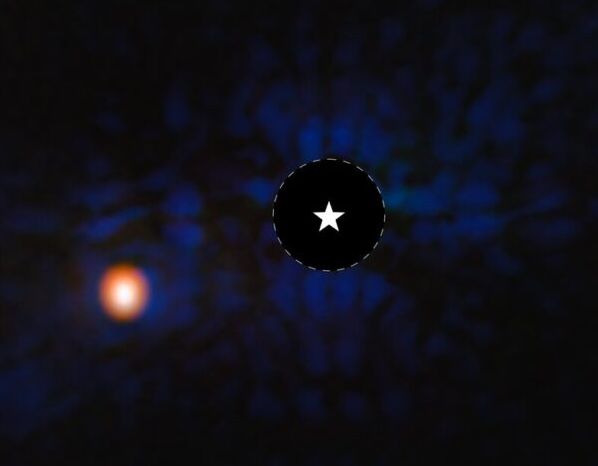One million kilometers from Earth, Webb can see farther than the human eye ever could. Almost three years have passed since its launch, and the demand for it among astronomers is so great that the demand for its observation time exceeds the supply nine times.
In May, astronomers announced that Webb had spotted the most distant galaxy ever found, a fuzzy blob of red light seen as it existed just 290 million years after the Big Bang. The light from this galaxy – hundreds of millions of times the mass of the Sun – traveled for more than 13 billion years before the photons hit Webb’s gold-coated mirror.
A few months later, in July, scientists published an image captured by Webb of a planet orbiting a star nearly 12 light-years from Earth and slightly cooler than the Sun. The alien world is several times the mass of Jupiter and the closest exoplanet ever directly imaged. One of Webb’s science instruments is a coronagraph, which blocks starlight so the telescope can detect faint signals from a nearby planet and use spectroscopy to measure its chemical composition.
These are just a taste of the discoveries made by the $10 billion Webb telescope since science observations begin in 2022. Astronomers’ interest in using Webb is huge, so there is certainly a lot more to come. The Space Telescope Science Institute – which operates Webb on behalf of NASA and its international partners – said last week it had received 2,377 requests from scientific groups seeking observing time from the observatory. At the beginning of the year, the institute launched a tender for the so-called “Cycle 4” series of Webb’s observations.
The amount of proposals represents about 78,000 hours of observing time, which is nine times more than the telescope’s capacity for scientific observations in this cycle. In the previous observation cycle, the “oversubscription rate” was similar, but overall less observation time was available to the scientific community.
More than 600 scientists will review applications and select the most promising to receive time on Webb. Most of the applications are aimed at observing “high redshift” galaxies belonging to the first generation of galaxies formed after the Big Bang. The light of such old and distant galaxies extends to longer wavelengths due to the expansion of the Universe. Research on exoplanet atmospheres and stars and stellar populations were the second and third most popular science categories this cycle.

This image of the gas giant planet Epsilon Indi Ab is taken by obscuring the star
Webb is a joint project of NASA, the European Space Agency and the Canadian Space Agency. The observatory’s 6.5-meter-diameter main mirror and four infrared instruments tuned to detect faint thermal energy from the cold blackness of space make it a particularly useful general-purpose research platform. In this cycle, astronomers study targets within the Solar System, exoplanets in the neighborhood of our star, gas and dust floating in interstellar space, supermassive black holes, and nearby galaxies.
The list is a remarkable array of science targets. Only the Hubble Space Telescope can meet similar demands, but Webb’s larger mirror allows it to observe objects 100 times fainter than Hubble. In less than two and a half years of scientific operation, Webb has only given astronomers a taste of its potential productivity. There is a high probability that Webb will see galaxies even older and more distant than the faint red beacon announced in May. There are thousands more known exoplanets for Webb to study, worlds of all sizes in our own solar system, and untold things Webb is sure to discover in the coming years.
Astronomers seem to have no shortage of ideas for where to point their lens. Perhaps one day new super-heavier rockets or advances in assembly in space will allow space telescopes even more sensitive than Webb to be deployed. In the meantime, we can be thankful that Webb is doing well and has a good chance of far outliving its originally planned five-year lifespan. Let’s continue to enjoy the show.
Source: sg.hu


